View in other NatureServe Network Field Guides
NatureServe
Montana
Utah
Wyoming
Idaho
Wisconsin
British Columbia
South Carolina
Yukon
California
New York
Sandhill Skipper - Polites sabuleti
Native Species
Global Rank:
G4
State Rank:
SU
Agency Status
USFWS:
USFS:
BLM:
External Links
General Description
[From Ferris and Brown 1981; Scott 1986; Layberry et al. 1998; Opler and Wright 1999; Glassberg 2001; Pyle 2002] Forewing 1.1-1.2 cm. Small, fringe yellowish. Uppersurface of male yellow-orange and extending along veins, with dark toothed borders and a sinuous forewing stigma; uppersurface of female with heavier dark markings, almost-transparent light spots. Undersurface of hindwing yellow-tan (in some areas chocolate-brown to gray) with yellow veins, pale-yellow to almost white postmedian chevron extending outward along veins and inwardly connected to basal spots, brownish spots between veins at the outer margin with dark spots at the vein ends.
Phenology
One flight, mostly mid-July to September in California, June to early September in Colorado; several flights, June to early September elsewhere; many flights mid-April to October in lowland California and Nevada (Scott 1986). June to September in one-brood areas, May to September in two-brood areas, April to September in three-brood areas (Glassberg 2001). Late June to mid-July for montane populations, May to September for lower elevation populations in the Rocky Mountain states (Ferris and Brown 1981). Mid-June to early August in Colorado (Scott and Scott 1978), mid-June to mid-August in northern California (Emmel and Emmel 1962; Shapiro 1977), early May to late October on Oregon and Washington (Pyle 2002), mid-May to early October in Oregon (Warren 2005), May to early September in British Columbia (Layberry et al. 1998).
Diagnostic Characteristics
Best determined by a combination of small size, yellowish fringe, undersurface of hindwing yellow-tan (in some areas chocolate-brown to gray) with yellow veins, pale-yellow to almost white postmedian chevron extending outward along veins and inwardly connected to basal spots, brownish spots between veins at the outer margin with dark spots at the vein ends.
Species Range
Montana Range
Range Descriptions
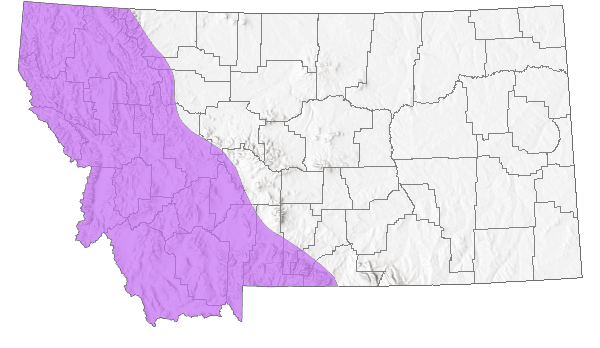
 Native
Native
Range Comments
British Columbia and eastern Washington south through California to Baja California, east to western Montana, southeastern Wyoming, central Colorado, and northeastern New Mexico (Ferris and Brown 1981; Scott 1986; Layberry et al. 1998; Opler and Wright 1999; Glassberg 2001; Guppy and Shepard 2001; Pyle 2002); to 2400 m elevation in the Rocky Mountain states (Ferris and Brown 1981), 2012 m to 2377 m elevation in Colorado (Brown 1957; Scott and Scott 1978), 2073 m to at least 2743 m elevation in northern California (Emmel and Emmel 1962; Shapiro 1977), 30 m to over 2438 m elevation in Oregon (Warren 2005), to 385 m elevation in British Columbia (Garland 1977; Guppy and Shepard 2001). In Montana, reported from at least 15 counties in the western 1/2 of the state, east to Wheatland County (Kohler 1980; Stanford and Opler 1993; FLMNH Lepidopterists' Society database), to at least 1585 m elevation. Locally uncommon in three-brood areas, rare to uncommon in two-brood areas, uncommon in one-brood areas (Glassberg 2001).
Observations in Montana Natural Heritage Program Database
Number of Observations: 10
(Click on the following maps and charts to see full sized version)
Map Help and Descriptions
Relative Density
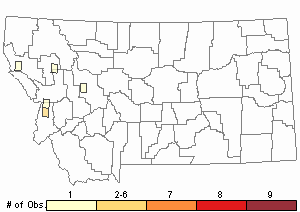
Recency
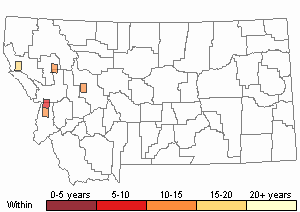
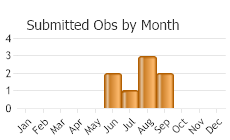
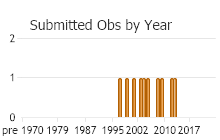
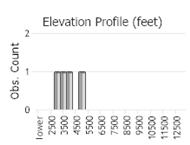 (Observations spanning multiple months or years are excluded from time charts)
(Observations spanning multiple months or years are excluded from time charts)
Migration
Non-migratory.
Habitat
Alkali grasslands, dry and moist meadows, lawns, parks, salt marshes, sand dunes, sagebrush flats, roadsides, ditch banks, riparian areas, above treeline in alpine terrain (Emmel and Emmel 1962; Shapiro 1977; Scott 1986; Opler and Wright 1999; Glassberg 2001; Pyle 2002; Warren 2005). Habitat in Montana not described but probably similar.
Food Habits
Larval food plants are native and exotic grasses, including Agrostis, Cynodon, Distichlis, Festuca (multiple species), Hordeum, Poa, Puccinellia, and Sporobolus (Shapiro 1977; Ferris and Brown 1981; Scott 1986, 1992, 2006; Graves and Shapiro 2003), also Setaria in captivity (James and Nunnallee 2011). Adults feed on flower nectar (including Astragalus, Carduus, Centaurea, Chrysothamnus, Cirsium, Cleome, Erigeron, Grindelia, Haplopappus, Helenium, Heterotheca, Machaeranthera, Medicago, Phlox, Polygonum, Solidago, Symphyotrichium, Taraxacum, Trifolium, Verbesina) and mud (Garland 1977; Pyle 2002; Warren 2005; Scott 2014)
Reproductive Characteristics
Females lay eggs singly on underside of host plant leaf, also on sedges, horsetail, soil near host plant (Scott 1986, 1992, 2006); one captive fall-brood female laid 40 eggs in 7 days (James and Nunnallee 2011). Fall eggs hatch in about 9 days (depending on temperature), develop to L5 instar and pupae in about 43 days (depending on temperature, adults eclose (emerge from pupae) in about 24 days; some larvae enter diapause before pupation. Spring brood eggs hatch in about 6 days, develop to L4 instar and pupae in 63 days, adults eclose (emerge from pupae) in about 35 days (James and Nunnallee 2011). Larvae feed on host plant leaves, live in silk-tied leaf-tube nests, pupate on inert surfaces either vertically or horizontally, enter diapause as pupae (Scott 1979, 1986; James and Nunnallee 2011) but possibly as larvae (Scott 1992; James and Nunnallee 2011). Males perch throughout the day in low grassy areas, on flowers in meadows, on low spots in alkali flats (do not hill top), awaiting passing females (Scott 1975b,1986).
References
- Literature Cited AboveLegend:
 View Online Publication
View Online Publication Emmel, T.C. and J.F. Emmel. 1962. Ecological studies of Rhopalocera in a High Sierran Community-Donner Pass, California. I. Butterfly associations and distributional factors. Journal of the Lepidopterists' Society 16:23-44.
Emmel, T.C. and J.F. Emmel. 1962. Ecological studies of Rhopalocera in a High Sierran Community-Donner Pass, California. I. Butterfly associations and distributional factors. Journal of the Lepidopterists' Society 16:23-44. Garland, J.A. 1977. An ecological note on Polites sabuleti sabuleti at the northern limit of its range (Hesperiidae). Journal of the Lepidopterist Society. 31:70-71.
Garland, J.A. 1977. An ecological note on Polites sabuleti sabuleti at the northern limit of its range (Hesperiidae). Journal of the Lepidopterist Society. 31:70-71. Graves, S.D. and A.M. Shapiro. 2003.Exotics as host plants of the California butterfly fauna. Biological Conservation 110: 413-433.
Graves, S.D. and A.M. Shapiro. 2003.Exotics as host plants of the California butterfly fauna. Biological Conservation 110: 413-433. James, D.G. and D. Nunnallee. 2011. Life histories of Cascadia butterflies. Corvallis, OR: Oregon State University Press. 447 p.
James, D.G. and D. Nunnallee. 2011. Life histories of Cascadia butterflies. Corvallis, OR: Oregon State University Press. 447 p. Opler, P.A., K. Lotts, and T. Naberhaus, coordinators. 2010. Butterflies and moths of North America. Big Sky Institute, Bozeman, MT. Available at: www.butterfliesandmoths.org (Accessed 15 June 2015).
Opler, P.A., K. Lotts, and T. Naberhaus, coordinators. 2010. Butterflies and moths of North America. Big Sky Institute, Bozeman, MT. Available at: www.butterfliesandmoths.org (Accessed 15 June 2015). Scott, J.A. 1975b. Mate-locating behavior of western North American butterflies. Journal of Research on the Lepidoptera 14:1-40.
Scott, J.A. 1975b. Mate-locating behavior of western North American butterflies. Journal of Research on the Lepidoptera 14:1-40. Scott, J.A. 1979. Hibernal diapause of North American Papilionoidea and Hesperioidea. Journal of Research on the Lepidoptera 18(3): 171-200.
Scott, J.A. 1979. Hibernal diapause of North American Papilionoidea and Hesperioidea. Journal of Research on the Lepidoptera 18(3): 171-200. Scott, J.A. 1992. Hostplant records for butterflies and skippers (mostly from Colorado) 1959-1992, with new life histories and notes on oviposition, immatures, and ecology. Papilio new series #6. 185 p.
Scott, J.A. 1992. Hostplant records for butterflies and skippers (mostly from Colorado) 1959-1992, with new life histories and notes on oviposition, immatures, and ecology. Papilio new series #6. 185 p. Scott, J.A. 2006. Butterfly hostplant records, 1992-2005, with a treatise on the evolution of Erynnis, and a note on new terminology for mate-locating behavior. Papilio new series #14. 74 p.
Scott, J.A. 2006. Butterfly hostplant records, 1992-2005, with a treatise on the evolution of Erynnis, and a note on new terminology for mate-locating behavior. Papilio new series #14. 74 p. Scott, J.A. 2014. Lepidoptera of North America 13. Flower visitation by Colorado butterflies (40,615 records) with a review of the literature on pollination of Colorado plants and butterfly attraction (Lepidoptera: Hersperioidea and Papilionoidea). Contributions of the C.P. Gillette Museum of Arthopod Diversity. Fort Collins, CO: Colorado State University. 190 p.
Scott, J.A. 2014. Lepidoptera of North America 13. Flower visitation by Colorado butterflies (40,615 records) with a review of the literature on pollination of Colorado plants and butterfly attraction (Lepidoptera: Hersperioidea and Papilionoidea). Contributions of the C.P. Gillette Museum of Arthopod Diversity. Fort Collins, CO: Colorado State University. 190 p. Scott, J.A. and G.R. Scott. 1978. Ecology and distribution of the butterflies of southern central Colorado. Journal of Research on the Lepidoptera 17(2): 73-128.
Scott, J.A. and G.R. Scott. 1978. Ecology and distribution of the butterflies of southern central Colorado. Journal of Research on the Lepidoptera 17(2): 73-128. Shapiro, A.M. 1977. The alpine butterflies of Castle Peak, Nevada County, California. Great Basin Naturalist 37(4): 443-452.
Shapiro, A.M. 1977. The alpine butterflies of Castle Peak, Nevada County, California. Great Basin Naturalist 37(4): 443-452.
- Additional ReferencesLegend:
 View Online Publication
View Online Publication
Do you know of a citation we're missing? Allen, T.J., J.P. Brock, and J. Glassberg. 2005. Caterpillars in the field and garden: a field guide to the butterfly caterpillars of North America. Oxford University Press.
Allen, T.J., J.P. Brock, and J. Glassberg. 2005. Caterpillars in the field and garden: a field guide to the butterfly caterpillars of North America. Oxford University Press. Brock, J.P. and K. Kaufman. 2003. Kaufman Field Guide to Butterflies of North America. Houghton Mifflin Company, New York, NY 284 pp.
Brock, J.P. and K. Kaufman. 2003. Kaufman Field Guide to Butterflies of North America. Houghton Mifflin Company, New York, NY 284 pp. Forister, M.L., C.A. Halsch, C.C. Nice, J.A. Fordyce, T.E. Dilts, J.C. Oliver, K.L. Prudic, A.M. Shapiro, J.K. Wilson, J. Glassberg. 2021. Fewer butterflies seen by community scientists across the warming and drying landscapes of the American West. Science 371:1042-1045.
Forister, M.L., C.A. Halsch, C.C. Nice, J.A. Fordyce, T.E. Dilts, J.C. Oliver, K.L. Prudic, A.M. Shapiro, J.K. Wilson, J. Glassberg. 2021. Fewer butterflies seen by community scientists across the warming and drying landscapes of the American West. Science 371:1042-1045. Forister, M.L., E.M. Grames, C.A. Halsch, K.J. Burls, C.F. Carroll, K.L. Bell, J.P. Jahner, et al. 2023. Assessing risk for butterflies in the context of climate change, demographic uncertainty, and heterogeneous data sources. Ecological Monographs 93(3):e1584. https://doi.org/10.1002/ecm.1584
Forister, M.L., E.M. Grames, C.A. Halsch, K.J. Burls, C.F. Carroll, K.L. Bell, J.P. Jahner, et al. 2023. Assessing risk for butterflies in the context of climate change, demographic uncertainty, and heterogeneous data sources. Ecological Monographs 93(3):e1584. https://doi.org/10.1002/ecm.1584 Glassberg, J. 2001. Butterflies through Binoculars: A Field Guide to the Butterflies of Western North America. Oxford University Press.
Glassberg, J. 2001. Butterflies through Binoculars: A Field Guide to the Butterflies of Western North America. Oxford University Press. Layberry, R.A., P.W. Hall, and J.D. LaFontaine. 1998. The Butterflies of Canada. University of Toronto Press. 280 pp. + color plates.
Layberry, R.A., P.W. Hall, and J.D. LaFontaine. 1998. The Butterflies of Canada. University of Toronto Press. 280 pp. + color plates. Stanford, R.E. and P.A. Opler. 1993. Atlas of western USA butterflies: including adjacent parts of Canada and Mexico. Unpubl. Report. Denver and Fort Collins, Colorado 275 pp.
Stanford, R.E. and P.A. Opler. 1993. Atlas of western USA butterflies: including adjacent parts of Canada and Mexico. Unpubl. Report. Denver and Fort Collins, Colorado 275 pp.
- Web Search Engines for Articles on "Sandhill Skipper"
- Additional Sources of Information Related to "Insects"





